Science & Technology - 2017
February
Probing the Mysteries of Hohlraum Plasmas
Record-Setting Petawatt Laser Meets Key Milestone
The Softer Side of NIF Hohlraums
Considering that nothing precious comes from an online retailer without protective padding, could precision laser targets also benefit from similar high-tech swaddling?
So far the answer is yes, for a group of scientists developing new target technologies for NIF that are intended to neutralize what they believe is one of the bigger challenges to achieving ignition.
The goal, said LLNL physicist Cliff Thomas, is to use a low-density foam liner to limit hohlraum wall motion—the problematic physics that come with forcing nearly two megajoules of energy into the hohlraum in a few billionths of a second (see “How NIF Targets Work”). If the density of the foam is low enough—some 100 times lighter than conventional metals like aluminum—having a well-behaved hohlraum could be just around the corner.
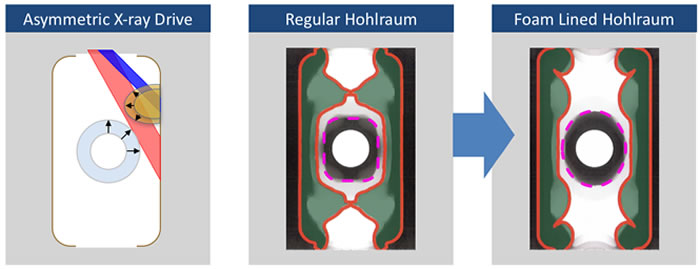 Comparison of regular and foam-lined hohlraums. Early results from using the liners suggest improved control of the NIF laser. Better control, researchers believe, could lead to higher fusion yields.
Comparison of regular and foam-lined hohlraums. Early results from using the liners suggest improved control of the NIF laser. Better control, researchers believe, could lead to higher fusion yields. Thomas leads the team developing the design of the new, highly specialized foam liners, while Suhas Bhandarkar leads the target fabrication development in a collaboration between LLNL and General Atomics (GA) that integrates experts in target design, target fabrication, and materials sciemce.
“The foams we can make are almost magic,” said Thomas, “but we need more practice at using them.” Thomas, a former intern who joined the Lab full-time in 2007, works in the Design Physics Division of the Weapons Complex and Integration Directorate.
“Our first tests have been promising," Thomas said. Ultimately, the goal of the project is to increase the energy coupled to the hohlraum and target capsule and increase the fusion yield that can be achieved at NIF.
The Problem
The hohlraum is a tiny gold canister mounted in a complex target assembly at the center of the NIF Target Chamber. Its purpose is capture laser light, convert it to x rays, and use those x rays to compress and heat a small capsule filled with hydrogen. 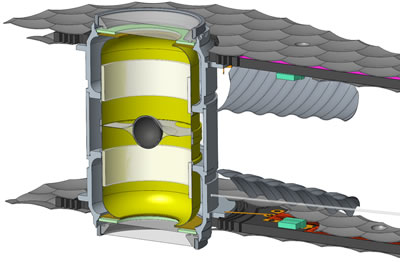 Rendering of a foam-lined hohlraum in a target assembly. Scientists believe the linings are robust enough to slow hohlraum wall motion during NIF experiments. To support NIF’s key missions in national security, Discovery Science, and energy security, the goal is to reach the conditions required for thermonuclear fusion.
Rendering of a foam-lined hohlraum in a target assembly. Scientists believe the linings are robust enough to slow hohlraum wall motion during NIF experiments. To support NIF’s key missions in national security, Discovery Science, and energy security, the goal is to reach the conditions required for thermonuclear fusion.
When NIF’s powerful lasers are directed at the hohlraum, its walls tend to collapse. “Essentially,” Thomas explained, “ the middle of the hohlraum fills with gold, and this keeps the laser from getting to where it needs to be.” By lining the hohlraum with padding, like the new specialized foams being developed at LLNL, the researchers hope to reduce wall motion and design targets that use the laser much more efficiently.
In concept, lining the core of the hohlraum sounds smart. But Thomas’ team needs foam liners thin enough to fit into the hohlraum and strong enough to not flake apart. They also need the foam to be uniform, so the laser can pass through without scattering from small imperfections.
‘Magic’ Solutions
Many of the foams so admired by physicist Thomas are being produced by a team led by Ted Baumann, a chemist who is group leader of Advanced Materials in the Physical and Life Sciences Directorate.
The first generation of foams used to test the hohlraum liner concept are made of tantalum oxide (Ta2O5). Baumann’s team utilizes a technique known as sol-gel chemistry to prepare the foams. “Basically, it works a lot like chemistry you can try in your kitchen,” Baumann said. "We dissolve the building blocks for the tantalum oxide foam in a liquid, much like you would with gelatin in making Jello.”
With care, these building blocks assemble to form a three-dimensional network. When the liquid is removed using a special process called supercritical drying, it leaves behind a tantalum oxide sponge, or foam, that typically is 100 times less dense than solid materials.
Baumann has spent more than 20 years developing materials to support Lab missions, but the hohlraum foams, “superhero” strong yet almost cloudlike in their lightness, have been a challenge. With recent advances, his group can now make foams that are even lighter—almost as light as air— and so delicate they can’t be touched directly.
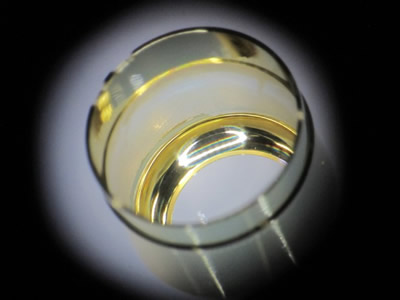 Close-up cutaway photo of a foam-lined canister utilized to reduce wall motion during NIF implosions. Researchers are experimenting with “superhero” strength foam liners that are two millimeters wide and 200 microns thick.
Close-up cutaway photo of a foam-lined canister utilized to reduce wall motion during NIF implosions. Researchers are experimenting with “superhero” strength foam liners that are two millimeters wide and 200 microns thick. The task of leading the target fabrication effort for turning these “magic” hohlraum physics concepts into reality falls to Bhandarkar, an engineer in the Laboratory’s Materials Science Division. “It is an exciting challenge,” Bhandarkar said,” and we see it as one of the important stepping stones in our quest for ignition.”
While Bhandarkar’s team is testing the tantalum-oxide foams, it’s also experimenting with alternative foam materials developed both at LLNL and at GA. Each has its advantages in target design, and constraints on target fabrication ultimately could determine which is best.
To transform the foams into actual liners, seven different approaches being developed by many experts in diverse technical fields are being beta-tested. So far the most successful involves shaping the foam to the desired dimension through the use of laser-cutter technology pioneered by Noel Alfonso at General Atomics. Foam liners also are being built piece-by-piece on a three-dimensional printer, which at LLNL is affectionately called “the Lego brick approach.”
Micron-level (millionth of a meter) precision is required. The parts must be small enough to fit into a hohlraum—smaller than a fingernail—and have edges that are close to perfect. The foams also need to hold their shape and satisfy strict requirements on their make-up throughout the many steps involved in doing a shot at NIF.
The Lab has considerable expertise working with foams and ultra-low-density aerogels, sometimes known as “frozen smoke.” Still, it has taken these new technologies to get to the point where a foam-lined hohlraum is a real possibility. With the help of the steady electronic hands of robotics, the team can make identical strips of the delicate foam, cut patterns for the laser to pass through, and shape the foam to the hohlraum perfectly.
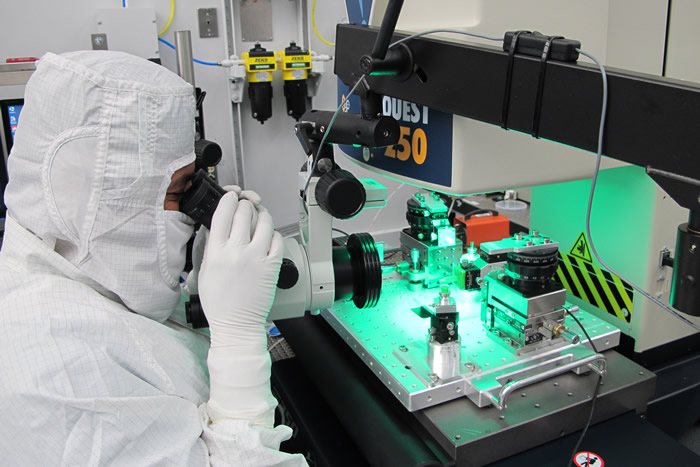 Ricardo Heredia of the Target Fabrication Engineering Team works on the assembly of a foam-lined hohlraum system into a cryogenic target. LLNL has developed a mechanized system for the insertion of the lined hohlraum into the thermomechanical package that contains the hohlraum and target capsule. It is customized to allow manipulation of hohlraums with fragile ultra-low density liners into precision assembly, to tolerances measured in microns, without damaging the ultra-sheer foam liner.
Ricardo Heredia of the Target Fabrication Engineering Team works on the assembly of a foam-lined hohlraum system into a cryogenic target. LLNL has developed a mechanized system for the insertion of the lined hohlraum into the thermomechanical package that contains the hohlraum and target capsule. It is customized to allow manipulation of hohlraums with fragile ultra-low density liners into precision assembly, to tolerances measured in microns, without damaging the ultra-sheer foam liner. In addition to the researchers already mentioned, the collaboration for developing protective padding for NIF targets has involved contributions from additional LLNL personnel including Kevin Baker, Alastair Moore, Monika Biener and Thomas “Mike” Reese. Laboratory scientists working on alternate techniques include Tyler Fears, James Oakdale, Sergei Kucheyev, Juergen Biener, Corey Horwood, and Tom Bunn. Lab partners at GA in foam-lining work include Jarrod Williams, Hannah Reynolds and Fred Elsner.
The research and development in foam-lining technology has shown substantial potential, Thomas said, and he believes it is starting to change how researchers think about target design.
“If you want to take a big step forward,” he said “then you typically need something else—a new set of tools—and foams are one of the technologies we think can really push the boundaries of what is possible.”Probing the Mysteries of Hohlraum Plasmas
Information that will literally shed new light on the dynamics of NIF fusion implosions will soon be available to researchers, thanks to an important diagnostic now under development.
When NIF’s laser beams enter a hohlraum, they generate an electrically charged plasma—a turbulent mix of ions and free electrons (see “How NIF Targets Work”). The plasma interacts with the laser beams and causes backscatter that can drain laser energy needed to symmetrically implode the fuel capsule. Gaining a better understanding of how laser-plasma interactions affect the hohlraum’s ability to successfully implode a target capsule could be a key to improving NIF’s implosion performance during the coming months.
Scientists have known for decades that one of the best ways to measure the characteristics of a plasma, such as its temperature and density, is with a diagnostic technique called optical Thomson scattering (OTS). Shining a strong laser beam called a “probe” into a plasma stimulates the electrons to oscillate and produce radiation in the form of visible or ultraviolet light that can be measured by the OTS diagnostic.
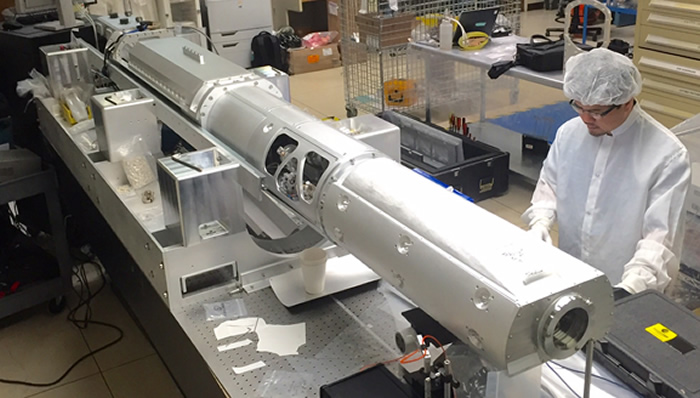 Streak camera expert Gene Vergel de Dios prepares the optical Thomson scattering detector for its use in a January NIF experiment to measure hohlraum background radiation.
Streak camera expert Gene Vergel de Dios prepares the optical Thomson scattering detector for its use in a January NIF experiment to measure hohlraum background radiation. The resulting data will be critical to understanding many aspects of hohlraum dynamics, including the transfer of energy when laser beams cross, the motion of the hohlraum walls, and the mixing of the hohlraum wall material and fill gas—all of which can significantly affect symmetry control and implosion performance. The diagnostic will also be used for direct-drive experiments, where Thomson scattering can probe the plasma conditions in the corona to validate laser coupling and thermal transport modeling.
“Thomson scattering is one of the very few diagnostics that gives us a very detailed, localized measurement,” said physicist Steve Ross. “We have a lot of other diagnostics that can look at very integrated parameters, but Thomson scattering is really a measurement at one place. That’s great for comparing experimental results to the models, because it’s very easy to tell how well they’re doing at modeling the target—or how not well they’re doing.”
Ross said the biggest uncertainties in modeling hohlraum dynamics center on hydrodynamic instabilities and plasma conditions. “We think we have a reasonably good understanding of the laser-plasma interaction processes, but modeling the exact plasma temperature and density tends to be what the codes have the most trouble with.”
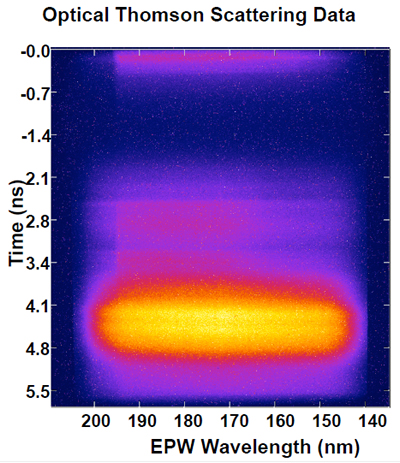 The OTS detector measured the ultraviolet background in a high-density carbon hohlraum.
The OTS detector measured the ultraviolet background in a high-density carbon hohlraum. The OTS diagnostic can peer into the laser entrance hole regions, where the lasers enter the target, and “tell us if we’re getting the temperature right, if we’re getting the plasma flow velocity right, if we’re getting the density right,” Ross said. “We have very detailed models on cross-beam energy transfer, but those are all predicated on understanding the plasma conditions. Verifying that we know the plasma conditions will help us better plan experiments going forward.”
And if improved understanding of hohlraum characteristics leads to improved models, “that will in turn allow us to improve the targets,” Ross said. “It’s this kind of continuous loop of modeling and experiment, to understand what’s going on and how can we make it better, that we need to carry out with our experiments and our targets.”
The OTS diagnostic has had to overcome a number of tough scientific and engineering challenges to reach its current stage of development. “We had to find the right approach that would have the highest probability of success without having to build a complete new NIF beamline-scope project,” Ross said.
The result is the combination of a sophisticated multi-part optical detector in a diagnostic instrument manipulator (DIM), and a small-scale laser mounted directly on the NIF Target Chamber. The detector, which has already been deployed on NIF experiments, can be used stand-alone at the ultraviolet (351-nanometer) wavelength of the NIF beamlines known as three-omega (3ω). When the OTS laser is completed, it can be tuned to the deep-ultraviolet (5ω) portion of the electromagnetic spectrum, with wavelengths ranging from 185 to 215 nanometers, for integrated Thomson scattering tests.
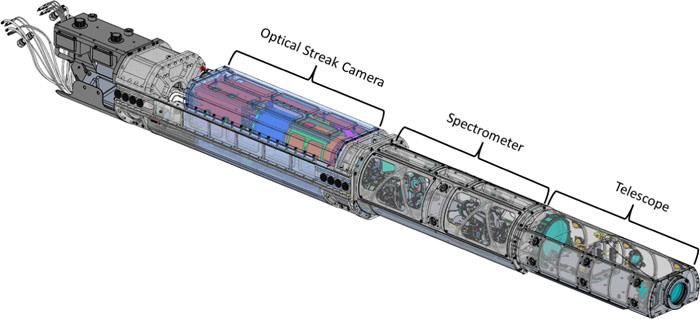 Diagram of the detector for the OTS diagnostic, one of the most complex optical diagnostics yet deployed on NIF. The assembly, which is inserted into the Target Chamber by a diagnostic instrument manipulator (DIM), includes a telescope, high-resolution and low-resolution spectrometers, a unique optical streak camera in a vacuum-sealed airbox, and a diode for measuring temporal shape.
Diagram of the detector for the OTS diagnostic, one of the most complex optical diagnostics yet deployed on NIF. The assembly, which is inserted into the Target Chamber by a diagnostic instrument manipulator (DIM), includes a telescope, high-resolution and low-resolution spectrometers, a unique optical streak camera in a vacuum-sealed airbox, and a diode for measuring temporal shape. “The five-omega laser was chosen for a particular reason,” said Phil Datte, the project’s lead engineer. “The NIF system has three colors in the Target Chamber which come from the main laser system—one omega (infrared), two omega (green), and three omega (ultraviolet)—and the unconverted light has a large background signal. The noise band, or the background band, is very strong in the two-omega and the three-omega range, but it falls off down to the 200-nanometer range.”
Because the five-omega wavelength is not in the same band as “all the other wavelengths that are flying around in the chamber,” he said, “it will allow us to have a better signal-to-noise ratio.” Datte noted that overcoming the background radiation at higher wavelengths would require a much more powerful laser, which could heat the plasma and distort the OTS measurements.
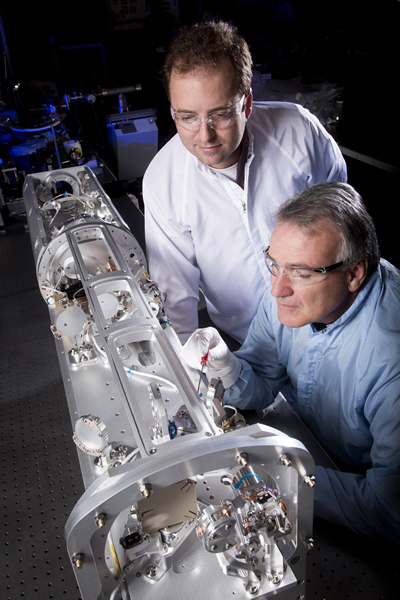 Steve Ross (left) and Phil Datte make adjustments in the disassembled OTS detector in preparation for the next series of experiments. Credit: Randy Wong
Steve Ross (left) and Phil Datte make adjustments in the disassembled OTS detector in preparation for the next series of experiments. Credit: Randy Wong In a recent series of experiments, the detector obtained good measurements of hohlraum background radiation, which will be used to determine how energetic the probe laser needs to be for the OTS diagnostic to obtain usable data from the low-signal-level Thompson scattering light.
One significant challenge facing the development team was dealing with the intense flux of x rays produced when the laser beams strike the inside surface of the hohlraum. These x rays heat the surface of the target capsule and drive the capsule’s implosion.
“When the target is emitting radiation in the x-ray band, and you have a window in your system, it makes that window become opaque” to OTS light, Datte said. “We’ve come up with a way to shield the x rays and allow the visible light, the light we’re interested in measuring, to pass through.”
Under the guidance of experimental physicist George Swadling, the team successfully tested their concept for mitigating x-ray “blanking” on the OMEGA Laser at the University of Rochester. They placed a diagnostic snout filled with pressurized xenon gas between the hohlraum and the OTS diagnostic. “The x rays are absorbed by the xenon and never make it to the window,” Datte said, “but the xenon is transparent to the visible light and the UV light that we measure.
“This is one of the first diagnostics where we’re actually inside the Target Chamber, close to the target, where we’re collecting data in the visible band and the UV band. Historically that was almost impossible to do at these x-ray fluxes. With this anti-blanking concept we’ve broken that barrier, and we’re able to collect measurements in that wavelength band without the interference of the x rays blanking out your system. That’s a really powerful mechanism that will open up the range of uses for these types of diagnostics.”
Ross said the diagnostic has the potential to characterize plasmas for other NIF platforms and Discovery Science experimental campaigns. The team plans to demonstrate the mitigation of x-ray blanking on NIF when experiments resume in April for additional calibration of the OTS detector.
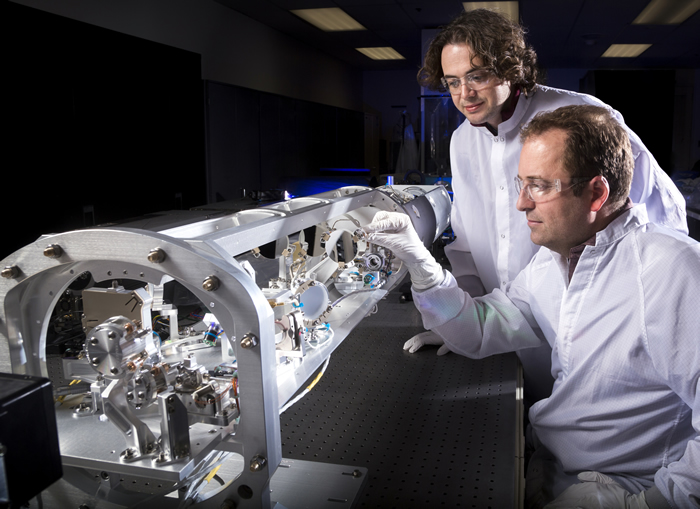 George Swadling (left) and Steve Ross inspect the wiring in the disassembled OTS detector. Credit: Randy Wong
George Swadling (left) and Steve Ross inspect the wiring in the disassembled OTS detector. Credit: Randy Wong Among the other challenges faced by the diagnostic’s development team are designing the architecture for precisely aligning the detector and the laser beam inside the Target Chamber, and obtaining large-scale CLBO (cesium-lithium-boron-oxygen) nonlinear crystals, which convert the laser light to 5ω, that can withstand the intense ultraviolet energy of the laser beams.
Both Ross and Datte expressed confidence that the project is proceeding according to plan. “There’s definitely work to be done,” Ross said. “It’s incredibly challenging; unfortunately, we don’t spend a lot of time working on easy problems. But so far, the measurements have been very, very nice and there’s a very optimistic outlook for the project as a whole.”
“We’re really excited about the performance of this device,” added Datte. “I’m sure we’ll have some growing pains, but this thing is really behaving very nicely.”
Joining Ross and Swadling on the OTS physics team are John Moody, Laurent Divol, Nino Landen and Pierre Michel of LLNL; Dustin Froula, Joe Katz, Chuck Sorce and David Turnbull of the Laboratory for Laser Energetics at the University of Rochester; David Montgomery and John Kline of Los Alamos National Laboratory; Jim Weaver of the Naval Research Laboratory; Siegfried Glenzer of the SLAC National Accelerator Laboratory; and Wojciech Rozmus of the Unversity of Alberta.
Along with Datte, members of the LLNL engineering/operations team are Jason Beagle, Ron Bettencourt, Mike Borden, Kelly Burns, Mike Fedorov, Gene Frieders, Justin Galbraith, Mike Hardy, Ben Hatch, Sukhdeep Heerey, Ray Iaea, Glen James, Steve Kramer, Brandi Lechleiter, Tony Lee, Stacie Manuel, Warren Massey, Tom Mccarville, Bill Molander, Kevin Person, Brad Petre, Mike Rayce, Mai Thao, Gene Vergel de Dios, Mike Vitalich, Scott Wilcox, Reg Wood, Tony Golod, and Valier Pacheu.
Record-Setting Petawatt Laser Meets Key Milestone
The LLNL-developed High-Repetition-Rate Advanced Petawatt Laser System (HAPLS) recently completed a significant milestone: demonstration of continuous operation of an all diode-pumped, high-energy femtosecond petawatt laser system at record average power.
With completion of this milestone, the system is ready for delivery and integration at the European Extreme Light Infrastructure Beamlines facility project (ELI Beamlines) in the Czech Republic, where it will be integrated with the facility and then ramped to its full design performance—one petawatt at a 10-Hertz (Hz) (10 times a second) repetition rate .
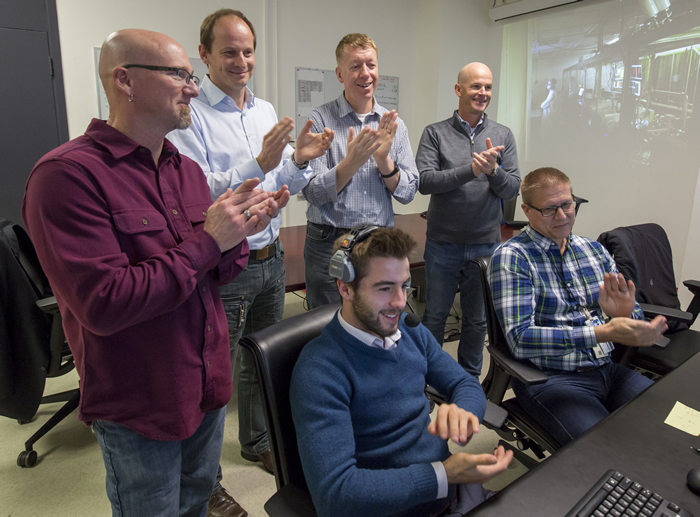 Members of the HAPLS Team applaud the system’s successful operation: (seated, from left) Sam Buck, ELI, and Shawn Betts, LLNL; (standing, from left) Joel Stanley and Constantin Haefner, LLNL, Bedrich Rus, ELI, and Jeff Horner, LLNL. Credit: Jason Laurea
Members of the HAPLS Team applaud the system’s successful operation: (seated, from left) Sam Buck, ELI, and Shawn Betts, LLNL; (standing, from left) Joel Stanley and Constantin Haefner, LLNL, Bedrich Rus, ELI, and Jeff Horner, LLNL. Credit: Jason Laurea HAPLS set a world record for diode-pumped petawatt (quadrillion-watt) lasers, with energy reaching 16 joules and a 28-femtosecond (quadrillionths of a second) pulse duration (equivalent to about 0.5 petawatt per pulse) at a 3.3-Hz repetition rate. An independent international review committee reviewed the results and confirmed the record-setting performance.
In just three years, HAPLS went from concept to a fully integrated and record-breaking product. HAPLS represents a new generation of application-enabling diode-pumped, high-energy and high-peak-power laser systems with innovative technologies originating from the U.S. Department of Energy’s fusion laser research and development.
“Lawrence Livermore takes pride in pushing science and technology to regimes never achieved before,” said LLNL Director Bill Goldstein. “Twenty years ago, LLNL pioneered the first petawatt laser, the NOVA Petawatt, representing a quantum leap forward in peak power. Today, HAPLS leads a new generation of petawatt lasers, with capabilities not seen before.”
In the decades since high-power lasers were introduced, they have illuminated entirely new fields of scientific endeavor, in addition to having profound impacts on society. When petawatt peak power pulses are focused to a high intensity on a target, they generate secondary sources such as electromagnetic radiation (for example, high-brightness x rays) or accelerate charged particles (electrons, protons or ions), enabling unparalleled access to a variety of research areas including:
- Time-resolved proton, neutron, and x-ray radiography
- Laboratory astrophysics and other basic science
- Medical applications for cancer treatments, and
- National security applications and industrial processes, such as nondestructive evaluation of materials and laser fusion.
Up to now, proof-of-principle experiments with single-shot lasers have provided a glimpse into this arena of transformational applications, but a high-repetition-rate petawatt laser is needed to commercially explore these areas.
“The high-repetition-rate of the HAPLS system is a watershed moment for the community,” said Constantin Haefner, NIF & Photon Science program director for Advanced Photon Technologies. “HAPLS is the first petawatt laser to truly provide application-enabling repetition rates.”
LLNL’s decades of cutting-edge laser research and development, and the Lab’s generations of world-class laser scientists and engineers both past and present, led to the key advancements that distinguish HAPLS from other petawatt lasers. Those advancements include:
- The laser’s ability to reach petawatt power levels while maintaining an unprecedented pulse rate
- Development of the world’s highest peak-power diode arrays, driven by a Livermore-developed pulsed power system
- A pump laser with the capability to generate up to 200 joules at a 10-Hz repetition rate
- A high-energy, high-average-power frequency doubler using temperature-stabilized large nonlinear crystals
- A gas-cooled short-pulse titanium-doped sapphire amplifier
- A sophisticated control system with a high level of automation including auto-alignment capability, fast laser start-up, performance tracking and machine safety
- Dual chirped-pulse-amplification high-contrast short-pulse front end, and
- A gigashot laser pump source for pumping the short-pulse preamplifiers.
In addition, HAPLS is to be the most compact petawatt laser ever built.
This expertise is why ELI Beamlines looked to Livermore to develop HAPLS. “It was quite straightforward,” said Roman Hvezda, ELI Beamlines project manager. “Given the design requirements, nobody else could deliver this system in such a short time on schedule and on budget. It’s a great benefit to be able to cooperate with Livermore, a well-established lab, and this will be a basis for continued cooperation in the future.”
This cooperation was in effect daily during construction, with LLNL and ELI Beamlines scientists and engineers working side-by-side on all parts of the laser system.
“One of the real successes of this endeavor was that very early on, the client was fully integrated into the commissioning and operation of this laser,” Haefner said. “This provided hands-on training and expertise right out of the gate, helping to ensure operational success once the laser is installed at ELI Beamlines. We look at this as a long-term and enduring partnership.”
Bedrich Rus, ELI Beamlines scientific coordinator for laser technology, agrees. “This was never a standard client-supplier relationship,” he said. “We have had about 10 people at LLNL—this integration is not only a very positive added value for the future operation of the facility, it’s been a great experience for their careers and development.”
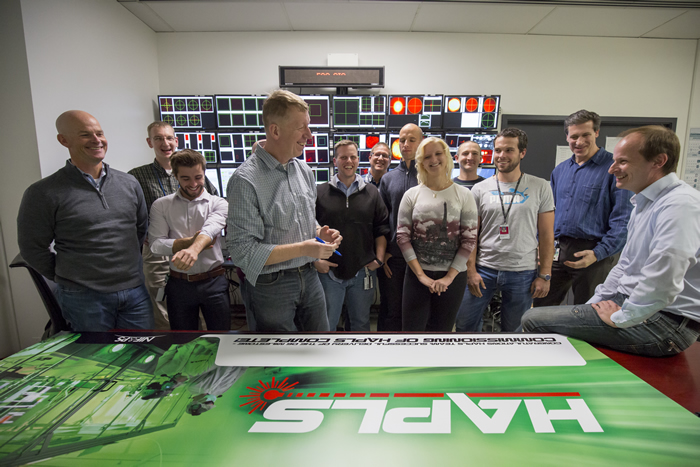 Members of the HAPLS team prepare to sign a commemorative poster celebrating completion of the milestone (from left): Jeff Horner and Tom Spinka, LLNL; Sam Buck and Bedrich Rus, ELI; Jeff Jarboe and Shawn Betts, LLNL; Jiri Thoma, Lucia Koubikova, Davorin Peceli, and Josef "Pepa" Cupal, ELI; and Andy Bayramian and Constantin Haefner, LLNL. Not pictured: Joel Stanley, Dan Mason, Daniel Smith, Bob Demaret, and Emily Link. Credit: Jason Laurea
Members of the HAPLS team prepare to sign a commemorative poster celebrating completion of the milestone (from left): Jeff Horner and Tom Spinka, LLNL; Sam Buck and Bedrich Rus, ELI; Jeff Jarboe and Shawn Betts, LLNL; Jiri Thoma, Lucia Koubikova, Davorin Peceli, and Josef "Pepa" Cupal, ELI; and Andy Bayramian and Constantin Haefner, LLNL. Not pictured: Joel Stanley, Dan Mason, Daniel Smith, Bob Demaret, and Emily Link. Credit: Jason Laurea In the coming months, HAPLS will be transferred to ELI Beamlines, where it will be integrated into the facility’s laser beam transport and control systems, then brought up to full design specification—delivery of pulses with peak power exceeding one petawatt firing at 10 Hz, breaking its own record and making it the world’s highest-average-power petawatt system. ELI plans to make HAPLS available by 2018 to the international science user community to conduct the first experiments using the laser.
“HAPLS was a very fast-paced project,” Haefner said. “In only three years it pushed the cutting edge in high-power short-pulse lasers more than tenfold, incorporating a completely new system approach. To do so, Livermore worked closely with industry to similarly advance the state of the art—and many of those joint Livermore/industry innovations are already on the market. These partnerships can be incredibly synergistic, resulting in successful and societal impactful technologies like HAPLS.”




